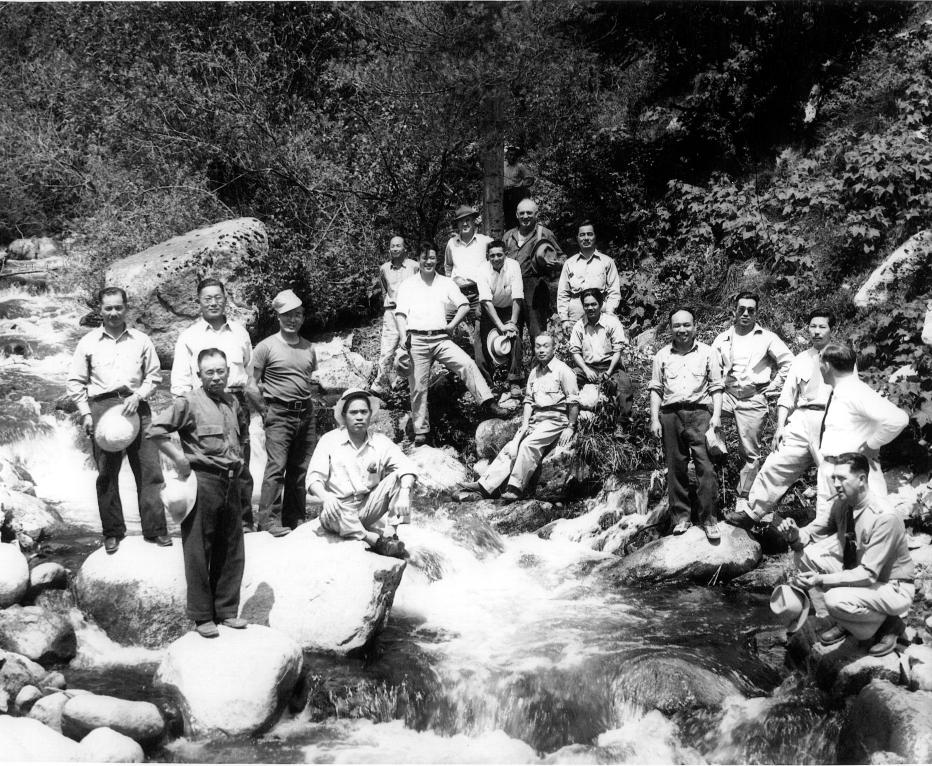

| Asian American Comparative Collection (AACC) University of Idaho 875 Perimeter Drive, MS 1111 Moscow, Idaho 83844-1111 USA 208-885-7075 |
Priscilla Wegars, Ph.D., Volunteer Curator pwegars@uidaho.edu Renae Campbell, M.A., RPA, Research Associate rjcampbell@uidaho.edu |

Immediately following Japan's attack on Pearl Harbor, numerous Japanese, German, and Italian aliens were arrested and detained on no specific grounds, without the due process guaranteed to them by the U.S. Constitution, and were sent to INS detention camps at Fort Missoula, Montana; Bismarck, North Dakota; and elsewhere. The INS camps were separate and distinct from the ten major camps under War Relocation Authority (WRA) supervision. The WRA camps, including Minidoka (now the Minidoka National Historic Site) near Jerome, in southern Idaho, housed some 120,000 American citizens and permanent resident aliens of Japanese ancestry who were unconstitutionally removed, relocated, and imprisoned by the U.S. government during World War II.
Although there were a number of
Justice Department internment camps throughout the United States
during WWII, the Kooskia Internment Camp was unique because it was
the only camp of its kind in the United States. Its inmates
had volunteered to go there from other camps, and received wages
for their work. A total of some 265 male Japanese citizens;
24 male and 3 female Euroamerican civilian employees; 2 male
internee doctors, one Italian and one German; and 1 male Japanese
American interpreter occupied the Kooskia Internment Camp at
various times between May 1943 and May 1945. Although some
of the internees held camp jobs, most of the men were construction
workers for a portion of the present Highway 12 between Lewiston,
Idaho, and Missoula, Montana, parallel to the wild and scenic
Lochsa River.
The Japanese internees at the
Kooskia camp came from Alaska, California, Colorado, Connecticut,
Florida, Hawai'i, Idaho, Illinois, Kentucky, Louisiana, Maryland,
Massachusetts, Minnesota, Montana, Nevada, New Jersey, New York,
Ohio, Oregon, Pennsylvania, Texas, Utah, and Washington. They
included Reverend Hozen Seki, founder of the New York Buddhist
Church; Toraichi Kono, former employee of Charlie Chaplin; and
Japanese Latin Americans kidnapped from their respective
countries, chiefly Peru, by U.S. government agencies. "Digging in
the documents" has produced INS, Forest Service, Border Patrol,
and University of Idaho photographs and other records. These,
combined with internee and employee oral and written interviews,
illuminate the internees' experiences, emphasizing the
perspectives of the men detained at the Kooskia Internment Camp.
Click here
for a list of California towns of origin or residence for Kooskia
internees.
Click
here for information on how to obtain Department of Justice
(DOJ) Closed Legal Case Files (CLCF) from the National Archives
and Records Administration (NARA).
Click here for a table of Justice Department and U.S. Army Internment Camps and Detention Stations in the U.S. during World War II.
Click
here for tables related to food and clothing at the Kooskia
Internment Camp.
Click here
for tables related to bids for services, if needed, covering
hospitalization and death [no deaths occurred] at the Kooskia
Internment Camp.
Click here to
learn about the Kooskia Internment Camp Archaeological Project,
directed by Dr. Stacey Camp.
Click here
for information on how to purchase Dr. Priscilla Wegars' two books
on the subject, As Rugged as the Terrain: CCC “Boys,” Federal
Convicts, and World War II Alien Internees Wrestle with a
Mountain Wilderness and Imprisoned in Paradise: Japanese
Internee Road Workers at the World War II Kooskia Internment
Camp.
For more information or to schedule
a talk, please contact:
Priscilla Wegars
Kooskia Internment Camp Project
735 East Sixth Street
Moscow, Idaho 83843
(208) 882-7905; pwegars@moscow.com